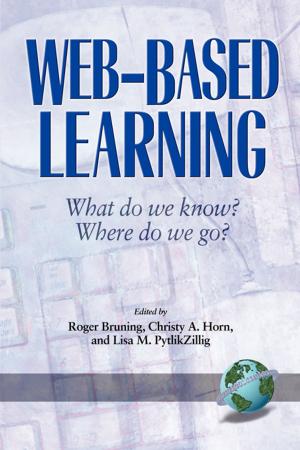What Works in Distance Learning
Sample Lessons Based on Guidelines
Nonfiction, Reference & Language, Education & Teaching| Author: | ISBN: | 9781607526483 | |
| Publisher: | Information Age Publishing | Publication: | February 1, 2008 |
| Imprint: | Information Age Publishing | Language: | English |
| Author: | |
| ISBN: | 9781607526483 |
| Publisher: | Information Age Publishing |
| Publication: | February 1, 2008 |
| Imprint: | Information Age Publishing |
| Language: | English |
The purpose of this book is to document sample lessons based on our What Works in Distance Learning: Guidelines (O'Neil, 2005). The intent is to provide an instantiation of our various distance learning guidelines. An overarching goal of our research was to create a robust and clear set of design guidelines and example lessons to support the next generation of distance learning systems. Each lesson in this book constitutes a case (Mayer, 2005) or partially worked example (Kalyuga, Chandler, Touvinen, & Sweller, 2001). A case is a description of a realistic problem scenario that is relevant to a particular profession or field of study (e.g., a case may be a distance learning lesson showing various instructors trying to design a lesson on a particular topic). A common topic could be, for example, how car brakes work, a surgery procedure, or electronics troubleshooting procedures (Mayer, 2003, 2005). In this book, the case format was useful for the guidelines developed for multimedia strategies, instructional strategies, and assessment strategies. A different format was used for the learning strategies, selfregulation strategies, and management strategies guidelines. The basic methodology in developing the guidelines for distance learning consisted of a research synthesis, conducted by experts, using analytical methods, on what is known about what works in distance learning. Research in the literature was reviewed for design flaws, and only studies with robust designs were included. Also, we included only those entries for which research evidence and expert opinion were stable and consistent. Furthermore, we decided that this information would be provided to researchers, instructors, program managers, and instructional or assessment designers in a "What Works" format, that is, What Works in Distance Learning. We adopted many of the conventions of What Works: Research About Teaching and Learning (U.S. Department of Education, 1986, 1987). Our goal for nonresearchers was to translate the research findings into clear and comprehensible statements that we think can help users to guide their practice. For both researchers and nonresearchers, the references cited for each finding provide an avenue to seek additional information. The guidelines are documented in O'Neil (2005).
The purpose of this book is to document sample lessons based on our What Works in Distance Learning: Guidelines (O'Neil, 2005). The intent is to provide an instantiation of our various distance learning guidelines. An overarching goal of our research was to create a robust and clear set of design guidelines and example lessons to support the next generation of distance learning systems. Each lesson in this book constitutes a case (Mayer, 2005) or partially worked example (Kalyuga, Chandler, Touvinen, & Sweller, 2001). A case is a description of a realistic problem scenario that is relevant to a particular profession or field of study (e.g., a case may be a distance learning lesson showing various instructors trying to design a lesson on a particular topic). A common topic could be, for example, how car brakes work, a surgery procedure, or electronics troubleshooting procedures (Mayer, 2003, 2005). In this book, the case format was useful for the guidelines developed for multimedia strategies, instructional strategies, and assessment strategies. A different format was used for the learning strategies, selfregulation strategies, and management strategies guidelines. The basic methodology in developing the guidelines for distance learning consisted of a research synthesis, conducted by experts, using analytical methods, on what is known about what works in distance learning. Research in the literature was reviewed for design flaws, and only studies with robust designs were included. Also, we included only those entries for which research evidence and expert opinion were stable and consistent. Furthermore, we decided that this information would be provided to researchers, instructors, program managers, and instructional or assessment designers in a "What Works" format, that is, What Works in Distance Learning. We adopted many of the conventions of What Works: Research About Teaching and Learning (U.S. Department of Education, 1986, 1987). Our goal for nonresearchers was to translate the research findings into clear and comprehensible statements that we think can help users to guide their practice. For both researchers and nonresearchers, the references cited for each finding provide an avenue to seek additional information. The guidelines are documented in O'Neil (2005).















